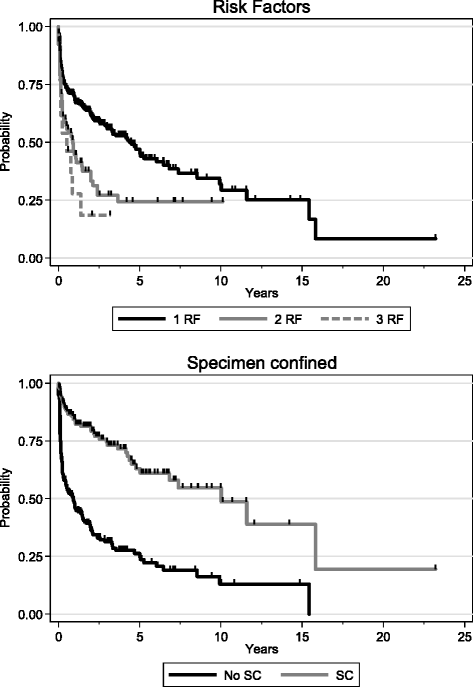Biochemical recurrence-free survival and pathological outcomes after radical prostatectomy for high-risk prostate cancer
- PMID: 27267988
- PMCID: PMC4897874
- DOI: 10.1186/s12894-016-0146-6
Biochemical recurrence-free survival and pathological outcomes after radical prostatectomy for high-risk prostate cancer
Abstract
Background: We propose to improve the prognostic assessment after radical prostatectomy (RP) by dividing high-risk prostate cancer (hrPCa) (according to the d'Amico classification) into subgroups combining 1, 2 or 3 criteria of aggressiveness (cT2c-T3a, PSA >20 ng/ml, Gleason score (GS) > 7).
Methods: Data from 4795 hrPCa patients who underwent RP in two French university hospitals from 1991 to 2013 were analyzed. Subgroups were formed to determine whether an increasing number (1, 2 or 3) of criteria of tumor aggressiveness was associated with poorer oncological results and early biochemical recurrence (BCR) (PSA > 0.2 ng/ml). These results were compared using Fisher's exact test and BCR was compared according to the Kaplan-Meier method.
Results: Eight hundred fifteen patients were treated by RP for hrPCa (8 %). Four hundred eleven patients (79.5 %) presented 1 RF (Risk Factor), 93 (18.0 %) 2 RF and 13 (2.5 %) 3 RF. Lymph node invasion and positive margin rates were 12.4 and 44.1 %, respectively. The prognostic sub-stratification based on these 3 factors was significantly predictive for adverse pathologic features and for oncologic outcomes. BCR free survival was respectively 56.4, 27.06 and 18.46 % for 1RF, 2RF and 3RF (p < 0.0001). However, no predominant negative criterion was found.
Conclusion: Oncologic results after RP are heterogenous within the hrPCa risk group. Sub-stratification based on three well-defined criteria leads to a better identification of the most aggressive cancers. On the other hand, RP provides both effective cancer control and satisfactory survival rates in patients with only one risk factor.
Keywords: BCR free-survival; High risk prostate cancer; Radical prostatectomy; Risk factors; Stratification.
Figures
Similar articles
-
Long-term cancer control outcomes in patients with clinically high-risk prostate cancer treated with robot-assisted radical prostatectomy: results from a multi-institutional study of 1100 patients.Eur Urol. 2015 Sep;68(3):497-505. doi: 10.1016/j.eururo.2015.06.020. Epub 2015 Jun 26. Eur Urol. 2015. PMID: 26119559
-
Radical prostatectomy represents an effective treatment in patients with specimen-confined high pathological Gleason score prostate cancer.BJU Int. 2013 May;111(5):723-30. doi: 10.1111/j.1464-410X.2012.11114.x. Epub 2012 Apr 4. BJU Int. 2013. PMID: 22487441
-
Tertiary Gleason pattern in radical prostatectomy specimens is associated with worse outcomes than the next higher Gleason score group in localized prostate cancer.Urol Oncol. 2018 Apr;36(4):158.e1-158.e6. doi: 10.1016/j.urolonc.2017.12.003. Epub 2017 Dec 27. Urol Oncol. 2018. PMID: 29288003
-
Assessing the Optimal Timing for Early Salvage Radiation Therapy in Patients with Prostate-specific Antigen Rise After Radical Prostatectomy.Eur Urol. 2016 Apr;69(4):728-733. doi: 10.1016/j.eururo.2015.10.009. Epub 2015 Oct 21. Eur Urol. 2016. PMID: 26497924
-
Preoperative Predictors of Biochemical Recurrence-Free Survival in High-Risk Prostate Cancer Following Radical Prostatectomy.Front Oncol. 2020 Sep 10;10:1761. doi: 10.3389/fonc.2020.01761. eCollection 2020. Front Oncol. 2020. PMID: 33014867 Free PMC article.
Cited by
-
Prognosis of men with high-risk prostate cancer stratified by risk factors: a population-based retrospective cohort study.Transl Cancer Res. 2020 Oct;9(10):6013-6025. doi: 10.21037/tcr-20-1578. Transl Cancer Res. 2020. PMID: 35117213 Free PMC article.
-
A transcriptomic signature for prostate cancer relapse prediction identified from the differentially expressed genes between TP53 mutant and wild-type tumors.Sci Rep. 2022 Jun 22;12(1):10561. doi: 10.1038/s41598-022-14436-y. Sci Rep. 2022. PMID: 35732666 Free PMC article.
-
Pseudogene Profiling for Cancer Subtype Classification.Methods Mol Biol. 2021;2324:307-317. doi: 10.1007/978-1-0716-1503-4_19. Methods Mol Biol. 2021. PMID: 34165723 Review.
-
Radical Prostatectomy and Pelvic Lymph Node Dissection in Kaiser Permanente Southern California: 15-Year Experience.Perm J. 2019;23:17-233. doi: 10.7812/TPP/17-233. Perm J. 2019. PMID: 30939263 Free PMC article.
-
Biochemical Recurrence in High-Risk Localized Prostate Cancer: A Comparison of Laparoscopic Prostatectomy and External Radiotherapy.Medicina (Kaunas). 2025 May 20;61(5):928. doi: 10.3390/medicina61050928. Medicina (Kaunas). 2025. PMID: 40428886 Free PMC article.
References
-
- Gerber GS, Thisted RA, Chodak GW, et al. Results of radical prostatectomy in men with locally advanced prostate cancer: multi-institutional pooled analysis. Eur Urol. 1997;32:385–90. - PubMed
Publication types
MeSH terms
Substances
LinkOut - more resources
Full Text Sources
Other Literature Sources
Medical
Research Materials
Miscellaneous


